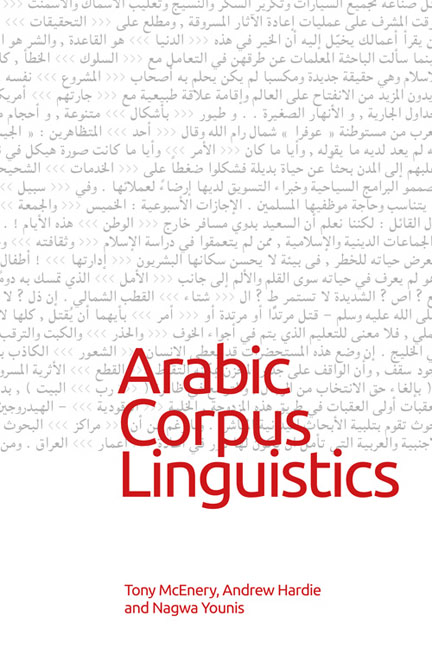Book contents
- Frontmatter
- Contents
- Notes on Contributors
- 1 Introducing Arabic Corpus Linguistics
- 2 Under the Hood of arabiCorpus
- 3 Tunisian Arabic Corpus: Creating a Written Corpus of an ‘Unwritten’ Language
- 4 Accessible Corpus Annotation for Arabic
- 5 The Leeds Arabic Discourse Treebank: Guidelines for Annotating Discourse Connectives and Relations
- 6 Using the Web to Model Modern and Qurʾanic Arabic
- 7 Semantic Prosody as a Tool for Translating Prepositions in the Holy Qurʾan: A Corpus-Based Analysis
- 8 A Relational Approach to Modern Literary Arabic Conditional Clauses
- 9 Quantitative Approaches to Analysing come Constructions in Modern Standard Arabic
- 10 Approaching Text Typology through Cluster Analysis in Arabic
- Appendix: Arabic Transliteration Systems Used in This Book
- Index
7 - Semantic Prosody as a Tool for Translating Prepositions in the Holy Qurʾan: A Corpus-Based Analysis
Published online by Cambridge University Press: 11 November 2020
- Frontmatter
- Contents
- Notes on Contributors
- 1 Introducing Arabic Corpus Linguistics
- 2 Under the Hood of arabiCorpus
- 3 Tunisian Arabic Corpus: Creating a Written Corpus of an ‘Unwritten’ Language
- 4 Accessible Corpus Annotation for Arabic
- 5 The Leeds Arabic Discourse Treebank: Guidelines for Annotating Discourse Connectives and Relations
- 6 Using the Web to Model Modern and Qurʾanic Arabic
- 7 Semantic Prosody as a Tool for Translating Prepositions in the Holy Qurʾan: A Corpus-Based Analysis
- 8 A Relational Approach to Modern Literary Arabic Conditional Clauses
- 9 Quantitative Approaches to Analysing come Constructions in Modern Standard Arabic
- 10 Approaching Text Typology through Cluster Analysis in Arabic
- Appendix: Arabic Transliteration Systems Used in This Book
- Index
Summary
Introduction
One of the most challenging aspects of translating the Holy Qurʾan is reflecting the shades of meaning conveyed by the use of certain prepositions in the Arabic text. Prepositions are used in the Holy Qurʾan not only as a syntactic requirement but also for a semantic and rhetorical function. It is the hypothesis of this research that there is a ‘semantic prosody’ related to the use of one preposition versus another in a certain linguistic context. This semantic prosody makes it inaccurate for the translator to make consistent use of the same English word as a translation equivalent for a given verb when the verb is followed by more than one preposition in various linguistic contexts.
The aim of this chapter is twofold, and is hence of importance to the field of corpus-based translation studies in general and to the translation of the Holy Qurʾan in particular. First, this chapter investigates the semantic prosody related to the use of certain prepositions (ʿalā, ‘on’; ʾilā, ‘to’; and li-, ‘for’) in verb-preposition constructions by examining the collocational patterns in which they occur. This corpus-based analysis will, hopefully, help translators to render the Arabic text into the target language while keeping the same semantic effect conveyed by the original preposition. As we will see, the use of two different prepositions with the same verb may result in two different meanings. This contradicts the notion held by some Arab grammarians, for example the Kufi School, that some prepositions in Arabic can be substituted for one another without a change in meaning (see, for example, Hassan 1974). Second, this chapter analyses the strategies adopted by translators to overcome these problems, with a view to providing translators with insights on dealing with the semantic prosodies of such patterns.
More specifically, the chapter is an attempt to answer the following questions:
1. How are specific semantic prosodies related to the use of certain prepositions in the Holy Qurʾan, especially in verb-preposition constructions?
2. In what way can this be detected through corpus analysis?
- Type
- Chapter
- Information
- Arabic Corpus Linguistics , pp. 120 - 142Publisher: Edinburgh University PressPrint publication year: 2018

